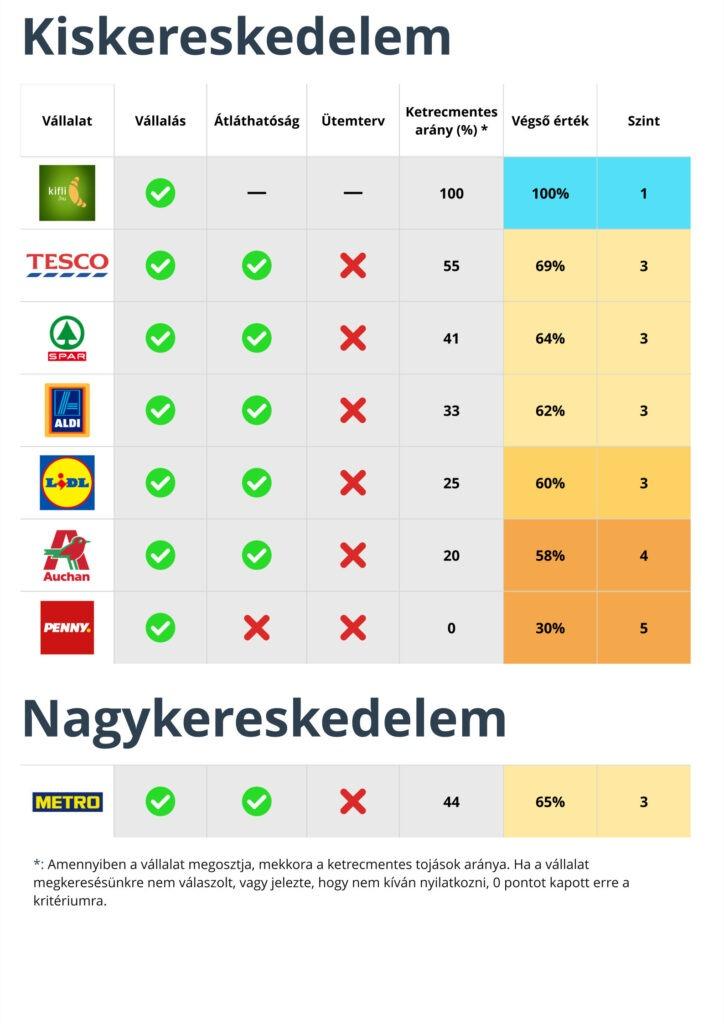More and more people, but not enough, are adopting the cage-free system
Only 20-30% of the nearly 8 million laying hens in Hungary live in alternative, so-called cage-free systems. The report on the cage-free transition by Farm Animal Protection and the Una Terra Foundation presents the results of domestic retail and wholesale chains that have committed to cage-free by the end of 2025.

Nowadays, sustainable purchasing practices and compliance with animal welfare standards in the case of food of animal origin are receiving increasing attention. Although cage farming, which ensures lower animal welfare, is still widespread in our country, more and more companies are striving for change.
Rearing methods
The rearing method is indicated by the first digit of the code stamped on the egg:
– Cage farming (3): The hens live in narrow wire cages, where each hen has 750 square centimeters of surface area, which is roughly the size of an A4 sheet of paper.
– Deep-litter housing (2): In this housing system, the hens still live in a closed building, but they are not caged, which allows them to move more freely, perch, scratch and lay their eggs in nests. The maximum permitted density is 9 hens per square meter.
– Free-range (1): Hens can go outside during the day through small doors in the building, where they can access a grassy area. There can be a maximum of 9 hens per square meter in the barn, while each animal must have a minimum of 4 square meters in the outdoor area.
– Organic housing (0): This is the strictest and most natural form of housing, where the hens are fed organic, GMO-free feed, and their living conditions are even more spacious and natural than in the case of free-range housing. A maximum of 6 hens can share one square meter in the barn, while in the outdoor area each hen must be provided with at least 4 square meters of free space.
Free-range (1) and organic (0) systems are the most suitable for the natural needs of hens, but for cost-effectiveness reasons these systems are less common among farmers. However, according to research by the Welfare Footprint Project, even switching from cages to deep-litter systems can reduce the amount of suffering experienced by hens by half.
Related news
Hungarian egg white slices were also bitten into in Vilnius and Riga
🎧 Hallgasd a cikket: Lejátszás Szünet Folytatás Leállítás Nyelv: Auto…
Read more >Egg prices near record high: European shortage caused by bird flu drives up prices
🎧 Hallgasd a cikket: Lejátszás Szünet Folytatás Leállítás Nyelv: Auto…
Read more >NAV: more than 800 kilograms of spoiled chicken meat found in a Slovak van
🎧 Hallgasd a cikket: Lejátszás Szünet Folytatás Leállítás Nyelv: Auto…
Read more >Related news
How do young adults celebrate?
🎧 Hallgasd a cikket: Lejátszás Szünet Folytatás Leállítás Nyelv: Auto…
Read more >Vajda-Papír celebrates Ooops!’s 15th anniversary with a hybrid AI campaign
🎧 Hallgasd a cikket: Lejátszás Szünet Folytatás Leállítás Nyelv: Auto…
Read more >Pre-holiday shopping at up to half price
🎧 Hallgasd a cikket: Lejátszás Szünet Folytatás Leállítás Nyelv: Auto…
Read more >






